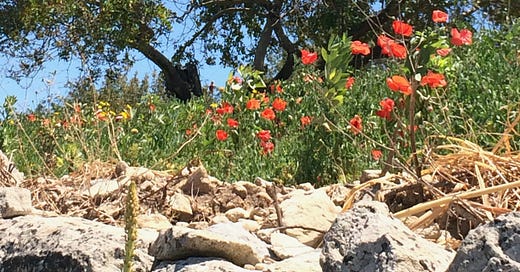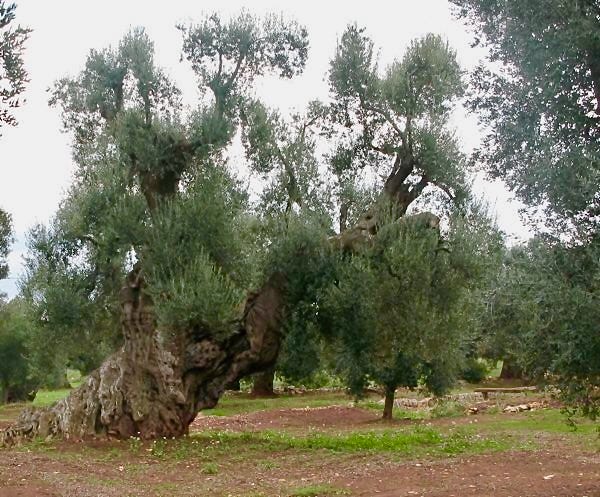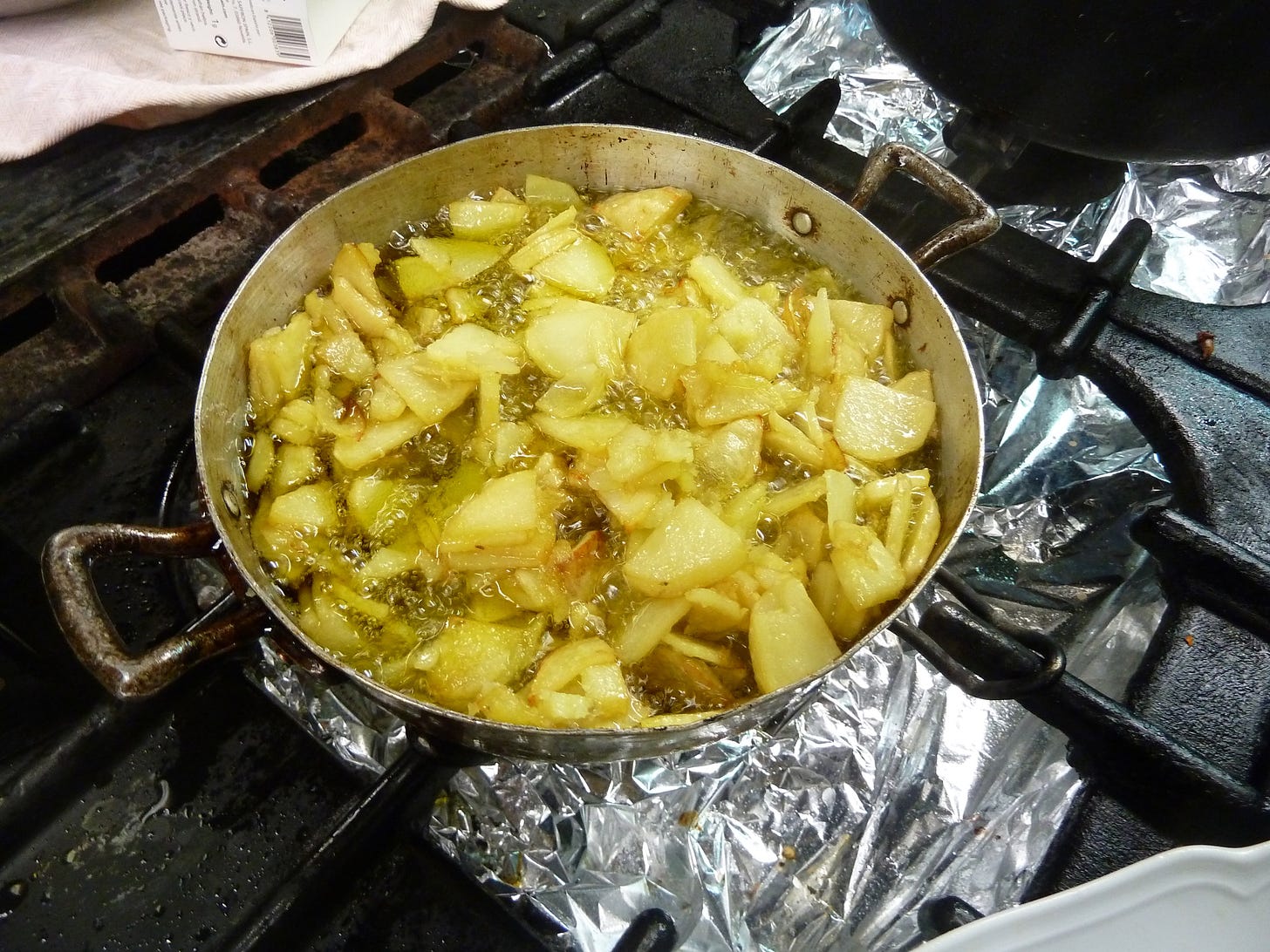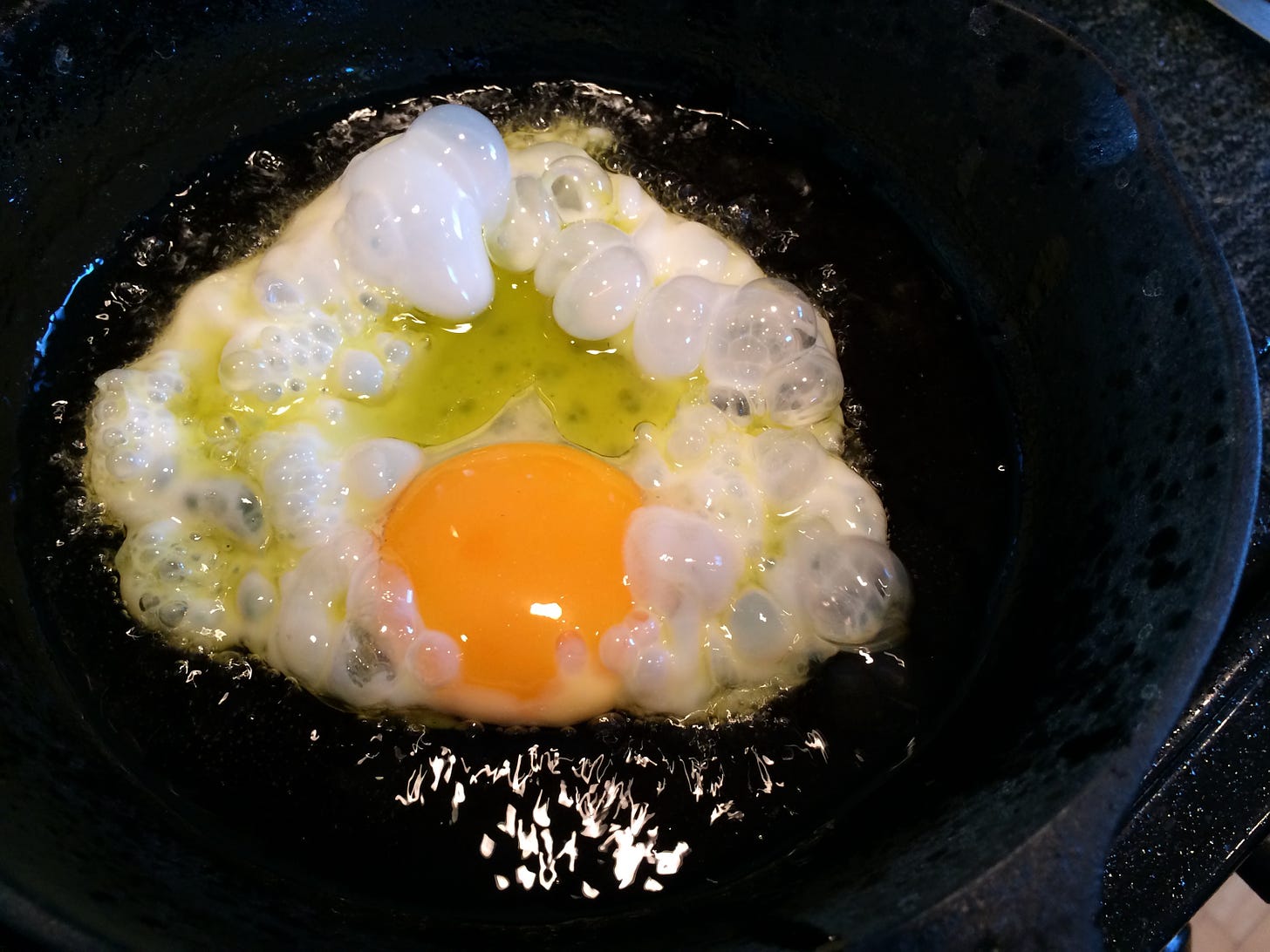Olive Tree Day
Plus wise words from Marcella (“You can only make sense about cooking if you write as a cook"), a holiday salad, and a celebrated whole-orange cake:
Last Sunday, November 26th was the official world-wide day to celebrate olive trees. World Olive Tree Day, I was reliably informed, is a project of the International Olive Council, and if you’ve never heard of it, you may be forgiven. Neither had I. However, in the ongoing spirit of Thanksgiving, I am happy to give enthusiastic thanks for olive trees and their almighty blessings, both olives and oil. It seems entirely appropriate right now when the olive harvest is reaching a climax and new oil is arriving in our shops and on our tables.
I’ve just received a bottle of fresh, new California oil, produced by the Yocha Dehe Wintun Nation, a Native American tribe who make oil from their own trees in the Capay Valley north of Sacramento. You can find it here. The oil, sold under the Seka Hills label, is one of my all-time California favorites, and it’s almost as good as our own oil (nothing, of course, is as good as our own production), which we make from olives grown on the family property in Tuscany. Our oil arrived in a rush shipment about ten days ago and, as usual, I was stunned by the impact of its green, lush flavor. My daughter claims it’s sweeter this year than last year’s oil and I have to agree—she has a much more sensitive palate than mine, although my taste memory isn’t strong enough to recognize the difference.
These ancient trees, from a grove near Ostuni in Puglia, the heel of Italy’s boot, are said to have been planted by Greek settlers long, long ago. It was the Greeks, they say, who brought olives to Italy. Or maybe it was the Phoenicians? So far back in any case that it’s unclear who was responsible, but these trees are survivors, that’s obvious from their gnarled and antiquated appearance. The fact that they still bear fruit is quite astonishing. It’s one of the reasons to hail the olive tree—its longevity is astounding. When you taste oil from these ancient trees, are you tasting something of Bronze Age Greece? I like to think so.
But survivors like these, alas, have been challenged in recent years by a newly emergent virus that poses a mortal threat, especially to such hoary elders. To date, Xylella fastidiosa has infected more than a third of all Puglia’s olive trees, and Puglia alone produces massive quantities of oil, about 12 % of total world production according to some estimates.
Efforts to combat the virus are intense and ongoing, often at a frantic pace, which doesn’t help, but no real solution has been found. The battle is not simply against a disease. Government efforts (and government investment) are needed and the Italian bureaucracy at all levels is notoriously slow, dragging its feet before any action, hoping if it closes its collective eyes, the problem will just go away. And when bureaucracy unites with an inbred Italian skepticism (is Monsanto to blame? is the Mafia involved?), the problem gets worse. There is a hint of good news, however, in a report presented to Italy’s Parliament six months ago that the virulence of the disease seems to be taming, at the same time that the rate of infection is going down. This may be the result of those stumbling, cross-cutting efforts to find a cure, or it may be just a natural progression. No one really knows.
Meanwhile, let’s continue to honor the olive tree as Athena’s great gift to humanity, representing good food and good health as well as the peace that we all crave so urgently now. Olives are as old as the Mediterranean itself and the olive tree is the very definition of Mediterranean no matter where it’s found, whether in California or other far-flung regions of Australia, South Africa, Chile, even Pakistan.
Marcella on Cooking with Extra-Virgin
In going through some old files the other day, I came across several encounters with the late, much-loved Marcella Hazan, the dean—or the doyenne—of Italian food in America. Without her wise counsel Americans might still be eating overcooked pasta with mountains of sauce and sprinkling it with a grated cheese-like substance from a shiny green tube. When Marcella spoke about Italian techniques or Italian ingredients, the rest of us, we learned, had darned well better pay attention.
And speak out she did a few years back, when Harold McGee questioned the wisdom of cooking with extra-virgin. McGee, you must know, is the author of the food-science Bible On Food & Cooking and an occasional writer about the science of cooking for the New York Times. It was in the Times that he reported on an olive oil tasting panel at the University of California at Davis. Four olive oils, three of them extra-virgin, were heated to 350ºF and held for five minutes, after which the panel reached the agreement that “they all tasted like popcorn.” McGee’s conclusion? Once heated, extra-virgin olive oils don’t have much olive flavor left: “In fact, they didn’t taste much different from seed oils.” Use expensive extra-virgin for cooking if that’s what you want to do, McGee said, in his amiable way, but in essence it’s a waste of good oil and of money
Marcella (calling her by her first name is as respectful as calling another celebrated cook, Julia) rose to the challenge. As a trained scientist, with degrees in natural sciences and biology, sheseemed to heave a sigh of regret on her Facebook page: “It was discouraging once again to see a scientist writing about cooking as a scientist,” she wrote. “You can only make sense about cooking if you write as a cook.” Yes, indeed, she agreed, by the time you’ve finished cooking with extra-virgin olive oil there are not a lot of flavors left in the pan. But what matters is not how the oil tastes when you’re done with it, but rather how the food tastes, how the good flavors of a fine oil are transferred to whatever is cooked in it, whether simple vegetables, braised chicken or fish, an aromatic pasta sauce, or even a humble fried egg.
Exactly! Just fry an egg in good extra-virgin and you’ll soon understand the difference between that egg and an egg fried in canola oil or corn oil or any one of a dozen other bland, flavorless oils on the supermarket shelf. Or indeed an egg fried in bacon fat. Or in butter. The humble egg fried in olive oil, like the egg in bacon fat or butter, will end up with character, with flavors and aromas undreamed of by your run-of-the-mill egg fried in ordinary vegetable oil. That’s because extra-virgin olive oil, like bacon fat, like butter, has flavors of its own to transmit to whatever is cooked in it. “What a good olive oil transfers to the food that is cooked in it,” Marcella went on to say, “is something that only a good olive oil can bestow: aroma and depth of flavor.”
The eggs I fry these days come from a neighbor’s chickens who scratch in the dust and live on a diet enriched with roots, grubs and garden bugs, but even the most ordinary hatchery egg can be transported to aesthetic heights by a bath in very hot olive oil.
Apart from frying eggs, however, should you cook with extra-virgin? There are so many myths circulating about what olive oil does or does not do that it’s no wonder cooks are bemused by the question. Olive oil, it’s claimed, has a low smoke point. But it really doesn’t, not when compared to other oils, and in any case, a smoke point of 400 to 410 degrees, which is where most olive oils fit, is way above any temperature at which you are going to want to cook. Deep-fat frying, according to the venerable Joy of Cooking, is best at 350º to 360ºF, no matter the fat that you use.
It's also said that olive oil is dangerous to consume after it’s heated. I haven’t a clue where this myth originated but one version concludes that olive oil somehow turns into a trans fat when heated. This is quite impossible—trans fats are created industrially. You could no more produce a trans fat in your home or restaurant kitchen than you could refine crude petroleum into gas for your car.
The extra-virgin you choose for cooking doesn’t have to be the finest oil on the market. Just as you wouldn’t use Chateau Lafite-Rothschild to make boeuf bourguignon, it would be foolish to use an expensive, freshly pressed, estate-bottled oil for deep-fat frying. There are plenty of very good, indeed excellent oils, widely available in U.S. markets, that are eminently appropriate, and they come from all over the world-wide map of olive oil—from California, Italy, Greece, Spain, even from Australia. (Two that I especially like are Iliada from Greece, and California Olive Ranch—but only the COR that is genuinely from California, stated on the label. And there are many others.) Buy in small quantities until you find one that particularly pleases you, then, for best value, purchase a big 3- to 5-liter tin. Store the tin in a cool, dark pantry cupboard and decant half a liter or so at a time to keep within easy reach in the kitchen. That will give your oil a much longer life span.
And use it tomorrow morning to fry your breakfast eggs.
In honor of the olive tree and its bounty, let me offer a seasonal treat, a Christmastime salad from Napoli, called Insalata di Rinforzo or, more simply, Insalata di Cavolfiore, cauliflower salad, which was served to me one year when I happened to be in Naples for Christmas. Like many traditional holiday dishes, this one comes with a story.
All over Italy, Christmas explodes with a constant round of festivities, beginning on December 8thwith the Feast of the Immaculate Conception, and continuing through Christmas and New Year’s and San Silvestro, finally culminating on January 6th, La Befana, the feast of the magi, when traditionally children were given gifts to commemorate the gifts brought by the three kings to the Christ child in the manger. Especially in Naples, an entire month is given over to eating, drinking, dancing, celebrating, calling on old friends and distant relatives, visiting the extravagant crêches that are erected in churches all over town, strolling the streets from the Quartieri Spagnoli and Spaccanapoli up to the Chiaia, accompanied by the haunting whine of shepherds’ bagpipes, and inhaling the fragrance of roasting chestnuts on every street corner. The ordinary, everyday chaos of Napoli is transformed into a virtual carnival.
Insalata di Rinforzo, reinforced salad, sits on the sideboard in every respectable household, along with trays of sweets and wedges of panettone, nuts and dried fruits, slices of prosciutto and salume, all ready to be presented to visitors with a ritual glass of sweet spumante or Moscato wine. It’s called reinforced salad, I was told, because it has to be constantly reinforced with new ingredients as guests help themselves to “just a little bit, please.” In this version it will keep in the refrigerator for a week or so but I do recommend starting a new batch every now and then, rather than reinforcing the old one.
In Napoli, the salad is often reinforced with giardiniera vegetables—vegetables that have been pickled and preserved in olive oil and vinegar. To my palate, the result is a dish in which ever ingredient tastes like every other ingredient. In my adaptation, I sometimes marinate carrots and celery beforehand for several hours before mixing.
This is often served as an antipasto but it might be offered as a merenda or pick-me-up snack to guests who drop in.
The rest of the post is available only to paid subscribers. please consider becoming one to join the conversation on the kitchen porch.
Keep reading with a 7-day free trial
Subscribe to On the Kitchen Porch to keep reading this post and get 7 days of free access to the full post archives.








